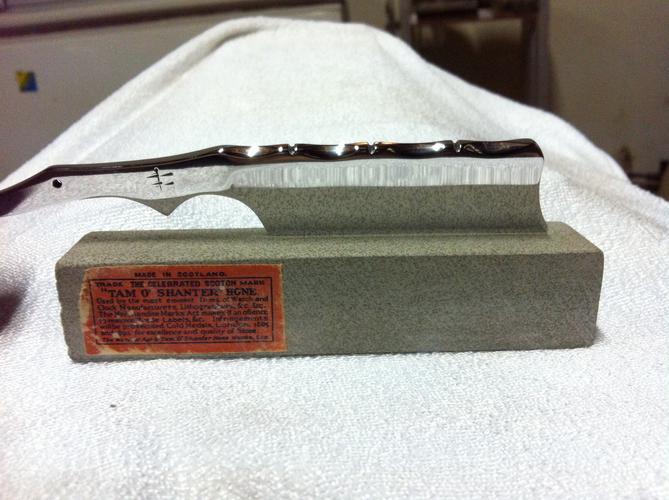Results 11 to 16 of 16
Thread: Tam O Shanter hones
-
05-01-2014, 12:32 PM #11Senior Member



- Join Date
- Apr 2008
- Location
- Essex, UK
- Posts
- 3,816
Thanked: 3164
Well, I think it is more or less true that a thin oil enhances the use of a fair number of natural honestones (eg LIs, slates, CFs, arkies, hindoos, etc - I have even got a number of very old coticules that were used with oil). I know that thuringians say keep away from oil, though!
I have used a thin oil with a tam, and I am of the opinion that it does improve the edge - only slightly, but it is noticeable. It is messy, however, so I changed to a thin honing oil that was miscible with water - still a bit messy, then glycerine - good, but sticky and needs washing off.
Eventually I settled on using a few drops of dish soap in the final honing water, or slathering the stone with shaving lather. Not quite as good an improvement as oil, but a lot cleaner!
Regards,
Neil
-
-
05-01-2014, 02:53 PM #12

The finest stone I have ever tried, aside from two Jnats I have, was a white TOS. Much finer than any Thuri, Charnleys, C12ks, fine slates, man made stones etc. I have tried, and best of all, the edge was not harsh at all.
I did found a big difference in performance when using oil (Smith's solution) compared to water, but it could also be because of the suction with water, I use slightly heavier pressure because of that.
First it seemed strange that an 6k stone could be so extremely fine, but as Mr. Henk says in his notes, they can be from 6k to final finishers.
-
05-01-2014, 05:17 PM #13Senior Member



- Join Date
- Apr 2008
- Location
- Essex, UK
- Posts
- 3,816
Thanked: 3164
I do like giving credit where it's due, and in this case it is due to owners of the Water of Ayr & Tam O'Shanter Hone Stone Works in Ayrshire, who pointed the differences out between the normal TOS and the white TOS at least 100 years ago.
The history of the mine and its owners goes back far into history - a quarry existed in 1789. A Mr Smith was involved in one of the quarries (stones from other quarries - Craiksland and Meikledale - were eventually brought to main quarry and sold from there) and in Mauchline ware, a decorative kind of wooden box, so we find a lot of WoA and TOS hone stones in these small boxes adorned with pictures, quite a few extolling the work of Robert Burns. The owners that most of us are familiar with are the Montgomerie family, of course. A fine cutting grade of WoA was named the Montgomerie Stone and it seems that yet another type of TOS came from the Meikledale quarry.
We may use (erroneously) grit ratings as a means of comparison, but back then they rightly eschewed that notion and denoted the stones as coarse, medium, fine and very fine. Both systems are equally applicable (given certain caveats) but Kudos for pointing this out in regards to Tams belongs in Ayrshire, Scotland.
There is an article on the web, aimed at woodworkers, on the use of jargon concerning abrasives. The author distinguishes betwen the new and the old simply by terming them 'newspeak' and 'oldspeak' - at least he realises that there isn't much new under the sun!
Regards,
NeilLast edited by Neil Miller; 05-01-2014 at 05:20 PM.
-
The Following User Says Thank You to Neil Miller For This Useful Post:
Vasilis (05-01-2014)
-
05-01-2014, 05:22 PM #14
-
05-01-2014, 11:27 PM #15

Am I correct in assuming that this is NOT a TOS White?
Tam O Shanter Hone Whetstone Razor Sharpening Stone International Shipping | eBay
-
05-02-2014, 01:13 AM #16


 23Likes
23Likes LinkBack URL
LinkBack URL About LinkBacks
About LinkBacks






 Reply With Quote
Reply With Quote

